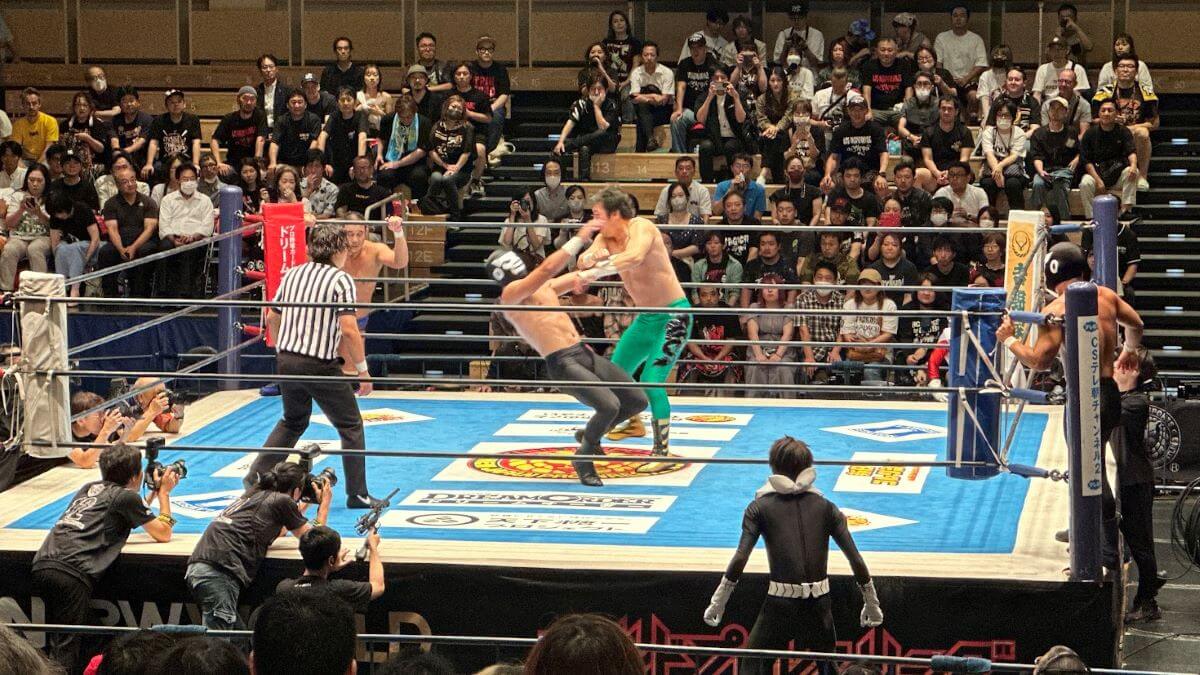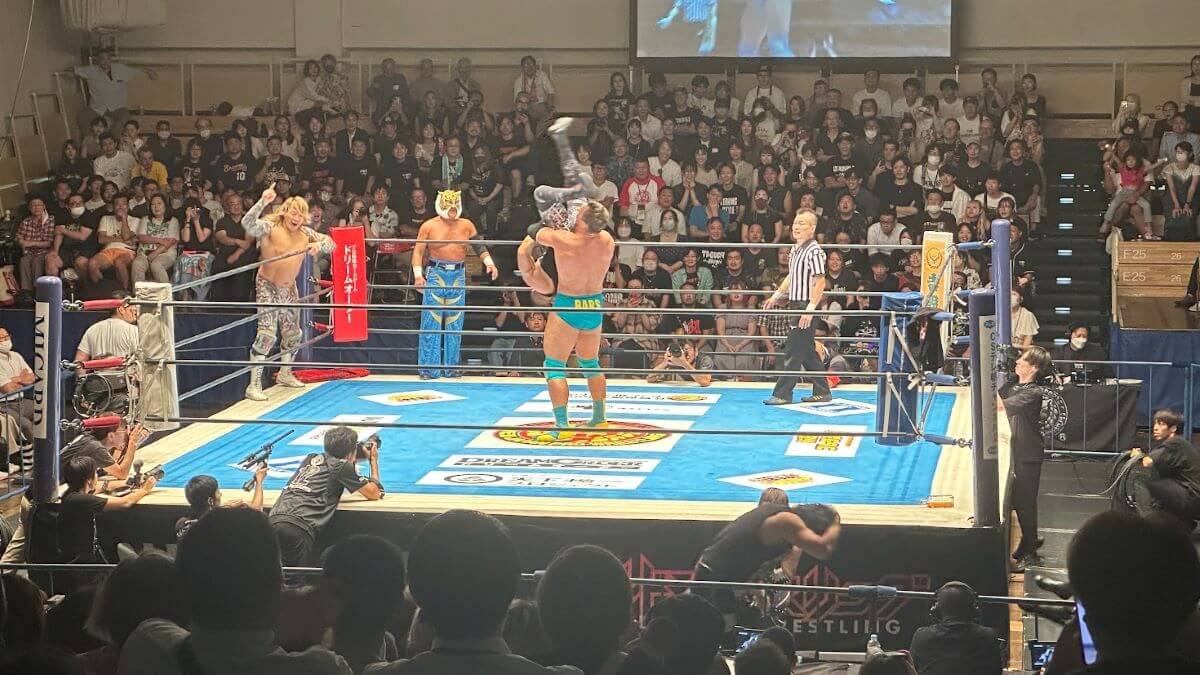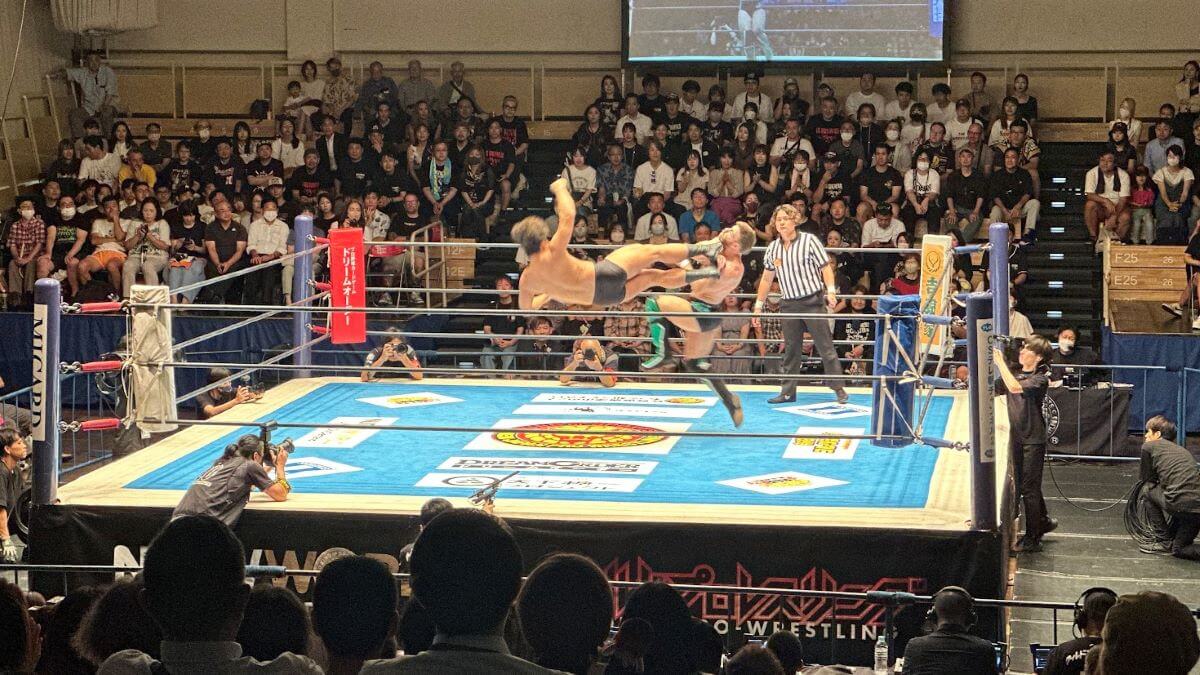- Life & Culture
Professional Wrestling in Japan: A Guide for ALTs
If you’re a foreigner newly living and working abroad in Japan, it can feel lonely at times.
But, one way to bond with your Japanese colleagues and friends is by chatting about pro wrestling! In this guide, we’ll give you an overview of the styles, stars, and fandom.
Or, if you’re an ALT (Assistant Language Teacher), how to talk to your students about it.
What is “puroresu”?
Professional wrestling in Japan or “puroresu” (プロレス) is a sport that has become a part of Japanese culture, enjoyed by many people.
It has a unique style, different from American, Mexican, or European style wrestling. Pro wrestling is also a distinct style from sumo and amateur wrestling in Japan. Puroresu played a part in the post-war economic recovery by giving Japanese people heroes to root for and bad guys to target their anger at.
For many Japanese people, including school-aged students that Interac ALTs teach, puroresu is a fandom as well as a way of escape from everyday life.
“When you are at a Japanese pro wrestling event, you can feel how passionate the Japanese fans are. Cheering at the top of their lungs, and then suddenly totally quiet before a big move, and then screaming when their hero wins.” Ryan, ALT in Ibaraki
A brief history of professional wrestling in Japan
It can help to have some background knowledge before you strike up a conversation.
The history of professional wrestling in Japan started in 1883 when Matsuda Sorakichi made his debut in the US. The first western-style wrestling match in Japan was in 1887.
The modern age of “puroresu” began in 1953, when the Japan Pro Wrestling Alliance (JWA) was founded. Wrestling quickly became a popular sport in Japan, along with sumo and baseball. However, baseball is still a clear winner when it comes to the most beloved sport in Japan!
Through the 1970s into the 1990s, Japanese wrestling culture developed its own style and gained popularity worldwide.
Pro wrestling in Japan isn’t as huge as it was in the 90s, but many of the classic pro wrestlers like Inoki and Baba are household names. If you’re talking to an older person in Japan, asking them about the glory days of pro wrestling could be a great way to find common ground.

Who are the biggest names in puroresu?
The main figure in the emergence of puroresu was Rikidozan, who is considered to be the Father of Japanese wrestling. Following his death in 1963, the number of promotions increased, and New Japan Pro Wrestling (NJPW) became the leading organization.
All Japan Pro Wrestling and Pro Wrestling NOAH emerged as competitors to NJPW. All of these organizations had regular televised events and weekly shows, which garnered popularity across ages and regions of Japan.
Some of the most famous puroresu stars in Japan are:
Antonio Inoki
Giant Baba
Jushin Thunder Liger
Tiger Mask
The Great Muta
If you’re talking with a pro wrestling fan in Japan, you may want to ask them who their favorite puroresu star is! Once you get into the fandom, you’ll probably have a favorite of your own.
Understanding Japanese pro wrestling
There are several styles of Japanese wrestling, which are distinct from styles overseas. It’s not uncommon to see a mixture of styles, depending on the production company and event.
- Strong Style is a hallmark of Japanese wrestling, emphasizing realism and physicality through hard-hitting strikes and submission holds that appear realistic and painful.
- Odou, or “King’s Road,” is known for its dramatic storytelling and psychological depth, where matches build to epic conclusions after wrestlers endure significant punishment.
- Shoot Style merges professional wrestling with real combat elements, incorporating martial arts techniques and a serious, technical approach to matches. It attempts to merge wrestling with martial arts.
- Hardcore Wrestling takes violence to the extreme, featuring brutal matches with weapons, unconventional rules, and high levels of physical punishment.
- Lucha Libre, a Japanese adaptation of the Mexican wrestling style, with high-flying maneuvers and fast-paced action. Masked wrestlers perform acrobatic and intricate moves, showcasing agility and athleticism.
What makes pro wrestling in Japan unique?
A distinctive feature of puroresu compared to wrestling in other countries is the emphasis on in-ring action vs out-of-ring performance.
The storytelling aspect is often linked to themes of underdogs vs heroes and appeals to the public. It’s also not a surprise to see a wrestler maintain the same character throughout their career, as opposed to western wrestling, where a particular wrestler may reinvent their character semi-frequently.
One special and extreme type of wrestling match known only to Japan is the “denryu bakuha deathmatch” (電流 爆破 デスマッチ) or “electrical exploding deathmatch”.
This is a match where the traditional ropes are replaced with electrified barbed wire that is linked to pyrotechnics. When a wrestler touches the wires, they are electrocuted and the pyrotechnics explode, leading to a very loud and shocking experience.

Major wrestling promotions in Japan
There are many current major professional wrestling promotions in Japan, divided into men’s and women’s promotions.
Crossovers between promotions occur, as well as mixed matches and events. In addition to the mainstream promotions outlined below, there are a large number of local and regional promotions in both men’s and women’s puroresu.
Men’s puroresu
New Japan Pro-Wrestling (NJPW)
The current #1 major wrestling organization in Japan, similar in notoriety to the WWE. It holds regular weekly house shows across Japan and premium events regularly throughout the year. NJPW incorporates most styles of puroresu, and is divided into World, Global, World Television, and Never divisions, with various titles in each division.
All Japan Pro Wrestling (AJPW)
Founded in 1972 and represents the Odou style of wrestling. Founded by “Giant” Baba, and aligned with NWA wrestling in the US, All Japan has been the long-term rival of NJPW, with many cross-promotion matches, defections, and rivalries.
Pro Wrestling NOAH
The upstart promotion, aligned with ROH and AEW in the US. It is also a sister organization of DDT and Tokyo Joshi Pro Wrestling. NOAH was started in 2000 by defectors from AJPW, and their style is generally mixed.
Dragon Gate
A new promotion, featuring high-flying maneuvers, grappling, and submissions, making it more of a hybrid style. It’s aligned with ROH and MLW in the US.
DDT Pro-Wrestling
This stands for “Dramatic Dream Team” is a newer promotion, following a sports entertainment style that often combines lucha libre and parodies of WWE as well as unorthodox outdoor matches (in campsites, buses, shinkansen trains, etc.)
Whether you prefer the WWE-like style of NJPW, the more traditional style of AJPW, or the modern flair of newcomers, Japan’s wrestling culture can be fascinating for a foreigner.
If you want to start a lively conversation, discuss your favorite style with a local in Japan.
Women’s puroresu (女子プロレス)
Women in professional wrestling in Japan started in the 1970s, with All Japan Women’s Wrestling (AJW) being the main organization. Currently, some of the major women’s wrestling organizations are:
World Wonder Ring Stardom
Referred to as simply “Stardom,” places a heavy emphasis on the physical attractiveness of the talent, employing many former bikini models and j-pop idols. Stardom is owned by NJPW.
Tokyo Joshi Pro-Wrestling (TJPW)
The sister organization of both DDT and NOAH, Tokyo Joshi tends to have flashier presentations with music performances and idol shows.
When can I see pro wrestling in Japan?
Each wrestling production usually has regular house matches and special events throughout the year. As an example, the typical yearly schedule for New Japan Pro Wrestling is like this:
- New Year’s: Wrestle Kingdom at Tokyo Dome – basically the Wrestlemania of Japanese wrestling.
- January: Fantasticmania – a tie-up between NJPW and CMLL where Mexican Lucha Libre stars come to Japan and wrestle.
- February: THE NEW BEGINNING – an event in Sapporo, typically where the challenger to the championship titleholder is declared.
- March: Flagship and NEW JAPAN CUP – Flagship is a rare match where unusual cards are held and NEW JAPAN CUP is a heavyweight singles tournament.
- April: Sakura Genesis – the follow-up to NEW JAPAN CUP where the heavyweight single title is challenged.
- May: Best of Super Jr. – a battle to determine the strongest young wrestler.
- June: Dominion – a general event to challenge almost every title.
- July-August: G1 Climax – a battle to determine the right to challenge the title matches up at Wrestle Kingdom the following year.
- September: Destruction – the follow-up to G1 Climax, full of revenge matches.
- October: Super Jr Tag League – tag team tournament.
- November: Power Struggle – another set of qualifying matches for Wrestle Kingdom.
- December: World Tag League – a tag team tournament with a number of overseas talent.
It’s possible to see similar types of events throughout the yearly schedule of every wrestling production. This makes it easy to enjoy a variety of styles and matches during the year.
If you’re in Japan and want to meet people, attending a pro wrestling match could be an idea.

Being a wrestling fan in Japan
Watching puroresu in Japan is very easy, and there are a number of TV and online platforms that feature wrestling content.
Online
- Abema TV is an online TV streaming service with a dedicated wrestling channel.
- New Japan Online is a NJPW online streaming service.
- Stardom Online is the Stardom online streaming service.
- Wrestle Universe is the NOAH, DDT, and TJPW online streaming service.
- DragonGate Network is the DragonGate online streaming service.
If you’re interested in other types of Japanese TV, check out our guides to J-drama and anime – you’ll have plenty to talk about with colleagues (or students if you’re teaching English in Japan).
Fandom is a big deal in Japan, and it’s a good way to make friends if you’ve moved here.
In-ring events
There are over 600 dojos, halls, and arenas nationwide where puroresu events are held annually. The most popular ones are:
- Korakuen Hall – the “holy ground” on Japanese wrestling (Tokyo)
- Shin Kiba 1st Ring – venue with the largest number of events per year (Tokyo)
- Ice Ribbon Dojo – Saitama
- Ichigaya Chocolate Hiroba – Tokyo
- Chiba Blue Field – Chiba
- Shinjuku Face – Tokyo
- Yokohama Radiant Hall – Kanagawa
- Edion Arena Osaka – Osaka
- Navel Kadena Arena – Okinawa
- Itabashi Green Hall – Tokyo
Tickets for events can be purchased from each promotion through their website online, or through ticket agencies like Ticket PIA or E+. Many convenience stores in Japan (Lawson, 7-11) also sell tickets through their multifunction kiosks.
Outside the squared circle
For serious fans, fan clubs are available from NJPW, NOAH, DragonGate and Stardom. Sign up on each of their respective websites.
Fanclubs give members access to exclusive content, as well as advance ticket sales and fan club-only events. Memberships may be monthly, charged to your mobile phone bill, or yearly for a fee, generally around 5000 yen per year.
A puroresu-themed steakhouse called “Ribera” is famous among pro wrestling fans. With memorabilia on the walls, including the signatures and photos of many famous Japanese and foreign wrestlers, the restaurant serves wrestler-sized steaks and is a must-visit for wrestling fans!
A number of other wrestling-themed restaurants, bars, and memorabilia shops in Japan are famous with fans, for a list of the most popular, see this article.
Sharing your passion for wrestling with students
A good number of students and teachers in Japan will be familiar with puroresu. If you’ve moved to Japan to teach English as an ALT, it can be a fun way to break the ice with local people.
“When I’d go to class, I’d psych myself up to go in like a wrestler and use my entrance in the classroom to get the students hyped about the class. The entrance is very important in wrestling, but I think we teachers neglect the fact that how we enter the class sets the theme for the whole class.” – an ALT from Interac
You may find that your JTEs/HRTs are fans, or that your students are into wrestling.
Incorporating professional wrestling themes into your lessons may be a way to keep your students interested in the lesson, and give you a commonly-understood frame of reference.
Some examples of how you can introduce puroresu in class:
- Keep puroresu references in mind when listening to students and teachers
- Ask the students if they like puroresu and who their favorite wrestlers are
- Put a classic pro wrestler like Giant Baba in a worksheet as a character
- Repurpose a popular classroom game with a wrestling theme
Sharing your passion for wrestling with the students may be the difference between a student being interested in your class or tuning out and not being enthusiastic about learning English.
Wherever you work in Japan, there are bound to be a few pro wrestling fans to talk to.

Final thoughts about pro wrestling in Japan
Hopefully, you’ve found this article interesting and have an insight into the world of wrestling in Japan. It’s an exciting form of sports entertainment and very popular with students.
Like football in the US and UK, a love of sport can transcend language or culture barriers!
As an inroad to Japanese culture, puroresu is an accessible medium that new ALTs can enjoy at any level of participation. At the very least, keeping an ear out for your students, or Japanese teachers at school, talking about wrestling may help create bonds at the individual level.
If wrestling isn’t your thing, there are plenty of growing fandoms in Japan, including K-Pop.
If you’re interested in experiencing the world of wrestling as an Interac ALT (Assistant Language Teacher, click below to get started. We can support you in your Japanese adventure.
About the Author

Brian McDonough is a consultant at Interac, Japan’s largest provider of ALTs (Assistant Language Teachers). Originally from the US, Brian has lived in Japan for over 25 years, giving him a unique perspective on the cultural differences and challenges people face when moving to Japan. He has first-hand experience of working in Japan as an American.





